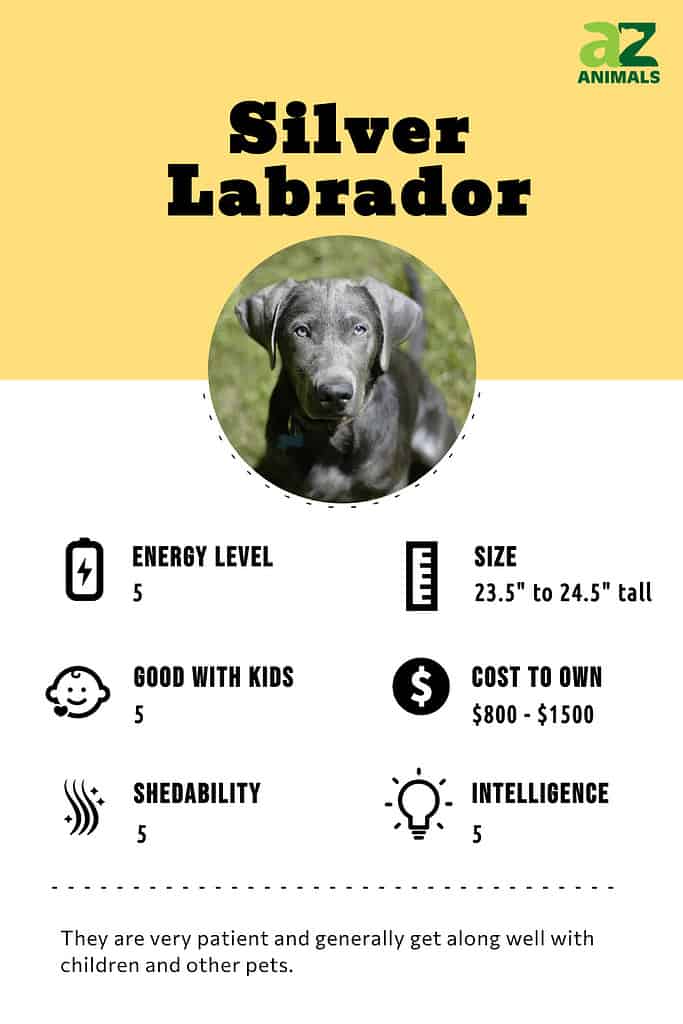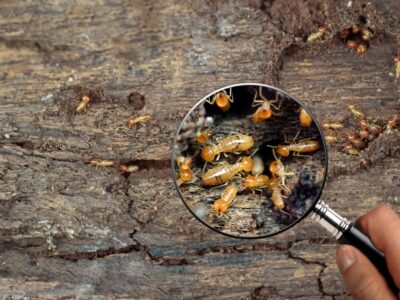Silver Labrador
Canis lupus
The Labrador is the most popular breed in the United States and most of these dogs have blue eyes at a young age, before they turn another color.
Advertisement
Silver Labrador Scientific Classification
- Kingdom
- Animalia
- Phylum
- Chordata
- Class
- Mammalia
- Order
- Carnivora
- Family
- Canidae
- Genus
- Canis
- Scientific Name
- Canis lupus
Read our Complete Guide to Classification of Animals.
Silver Labrador Conservation Status
Silver Labrador Facts
- Fun Fact
- The Labrador is the most popular breed in the United States and most of these dogs have blue eyes at a young age, before they turn another color.
- Temperament
- Intelligent, loyal, and outgoing
- Diet
- Omnivore
Silver Labrador as a Pet:
- General Health
- Energy Level
- Shedability
- Trainability
- Intelligence
- Tendency to Chew
- Size
- Family and kid friendliness
- Yappiness / Barking
- Moderate
- Separation Anxiety
- Moderate
- Preferred Temperature
- Average climate
- Exercise Needs
- High
- Friendly With Other Dogs
- High
- Pure bred cost to own
- $800-$1500 USD
- Dog group
- Non-sporting
- Male weight
- 55-80 lbs
- Female weight
- 45-70 lbs
This post may contain affiliate links to our partners like Chewy, Amazon, and others. Purchasing through these helps us further the A-Z Animals mission to educate about the world's species.
View all of the Silver Labrador images!
The Silver Labrador has blue eyes at an early age, until about 6-8 months, before their eyes turn yellow!
For decades now, Labradors are topping the American Kennel Club (AKC)’s annual list of most popular dog breeds. Silver Labradors, which accompany yellow, chocolate, and classic black Labradors, are increasing in popularity, as well.
The only real difference between Silver Labradors and the traditional colors is their grayish-blue coat and blue eyes in early life! Like all other Labradors, these medium to large-sized dogs is adored for their outgoing, energetic, and loyal personalities.
See all of our expert product reviews.
As sociable dogs, they need lots of exercise, especially as Silver Labradors are sometimes categorized as a type of Chocolate Labrador but differ genetically due to a ‘dilute gene.’ This essentially means that there is a specific gene that causes the color of the coat to show up in a lighter or more diluted color, hence this name, dilute gene.
Many dog breeds carry the dilute gene, but it is relatively new in Labrador retrievers, which means that Silver Labradors were quite rare up until very recently. This might explain why they are still classified as Chocolate Labradors, for now.

3 Pros And Cons Of Owning A Silver Labrador
| Pros! | Cons! |
|---|---|
| A unique and unusual dog! The Silver Labrador is unique in its coat, which stems from a rare combination of recessive genes, known as diluted genes. | Unpleasantness from others Some Silver Lab owners receive unpleasant reactions from those who think that their labs are ‘ruining’ the breed. This is more of a minor inconvenience, if anything, but something to be aware of. |
| Playful and family-friendly! Considering a rescue but want to be sure that the kids will get along with him or her? Silver Labradors are a very playful breed of dog. They’re affectionate, kid-friendly, good companions, and great for active owners! | Possible risk of alopecia The diluted gene in Silver Labs can cause color dilution alopecia (CDA), which manifests as flaky, itchy skin, and hair loss. |
| As lovable and trainable as any other lab If you are looking to adopt or buy a dog but have little to no experience with training, this is your breed! They respond exceptionally well to positive reinforcement and short training sessions. Small treats will make this all even easier! | Difficulty in finding responsible breeders It may be difficult to find breeders that are both reputable and ethical, only allowing the female Labrador to produce 3-4 litters before retiring her. |
History Of The Breed

Silver is not a formally recognized labrador color.
©cmcclave, CC BY 2.0 <https://creativecommons.org/licenses/by/2.0>, via Wikimedia Commons – License
The silver labrador, while a relatively new color for the breed, and considered more of a gene dilution rather than a color, has an older history for the specific dog itself, which dates back to the 1800s. Originating in the Canadian Province of Newfoundland, they have ancestors in the St. John’s water dog, which was discovered by European settlers and then bred with British hunting dogs to eventually get what was known as the labrador retriever. The recognized colors are black, yellow and chocolate and the silver labrador is registered in the US under the color chocolate.
Health and Entertainment for your Silver Labrador
See all of our expert product reviews.
Size And Weight
Full-grown Silver Labrador males usually weigh between 55-80 pounds at full maturity while their female counterparts tend to be a bit lighter at 45-70 pounds. The standard height for all Silver Labs is 23.5-24.5 inches tall at the shoulders.
| Height (Male) | 24.5’’ tall |
| Height (Female) | 23.5’’ tall |
| Weight (male) | 70 lbs, fully grown |
| Weight (female) | 15 lbs, fully grown |
Common Health Issues
With a lifespan of 10-14 years, this Labrador tends to have similar health to all other Labs, but there are a few things to be aware of.
Like other Labs, Silver Labradors can suffer Hip/Elbow Dysplasia and Patella Luxation. The first step to avoiding major health issues is finding reputable breeders that can give you background information about your Silver Labrador puppy. Although many kennels will provide health screenings to let you know of your puppy’s genetic risk, any Labrador can develop these conditions.
Hip and Elbow Dysplasia occurs when a Lab’s hip or elbow joints develop abnormally. The ball and socket joint in Labradors’ hips and can severely affect the animals’ movement and range of motion later in life, and the same is true in the elbow. But fortunately, if caught early, it can usually be managed with medication and physical therapy exercises. However, in some cases, it might require corrective surgery. Patella Luxation causes your Labrador puppy’s knee to dislocate and fail to extend but is most often successfully corrected with surgery.
The price of their beautiful, unique coats from their diluted genes means that Silver Labs do unfortunately have additional health risks. For instance, Color Dilution Alopecia (CDA) is a genetic disorder that causes skin to be flaky and itchy, along with hair loss. Also, the diluted gene can cause follicular dysplasia, making it difficult or even impossible to achieve new hair growth. The first sign will typically show up around 6 months and is thinning of the coat.
Overall, the Silver Labrador has a decent lifespan and will likely not have any serious health issues. However, in sum, the most common health issues with Silver Labs are:
- Patella Luxation
- Color Dilution Alopecia
- Hip and Elbow Dysplasia
- Follicular dysplasia
Temperament
The Silver Lab famously has a sweet, playful personality. This loyal and energetic dog has generally good behavior and gets along with other dogs and people alike. Usually a little prone to nipping, or playful biting, it will require patience while young. This breed will continue displaying puppy-like behavior as it matures, becoming bouncy and active as a ‘teenager.’ These loving and fun personality traits make it hard not to fall in love with Silver Labs.
How To Take Care Of A Silver Labrador
Silver Labradors, especially puppies, should get physical and mental stimulation to avoid restlessness and destructive behavior. When socialized young, they love interacting with the whole family and other animals which makes them fantastic pets.
The Best Dog Food For Silver Labradors
Silver Lab puppy dog food: Because of their size and genetic makeup, Silver Labs have a high tendency to develop hip and elbow dysplasia. When considering wet or dry dog food for puppies consider one with higher calcium to avoid these issues later in life. Other good options include chicken and fish.
Silver Lab adult dog food: Full-grown Silver Labs are just as food motivated as their classic counterparts, meaning that food should be kept secure. Adult Labs require 1650-2400 calories per day of high-quality, protein-rich food. To make digestion easier, it is ideal for their daily needs to split up into two separate mealtimes. Monitor food intake and, yes, this does include treats!
At A-Z Animals, we prefer Victor Super Premium Dog Food – Performance Dry Dog Food – 26% Protein for Active Adult Dogs as the best dog food for Silver Labradors.
This is a fully-balanced dog food with beef and chicken. It cares for your dog’s skin and coat, digestion, immune system, joints, and helps build lean muscle. The glucosamine helps prevent conditions that cause bad knees, hips, and elbows, and the biotin, vitamin E, and amino acids improve the condition of the skin and fur.
Check Chewy or Amazon for this product.
- PERFORMANCE DOG FOOD: Performance high energy dog food is a nutrient-dense dry dog food for adult dogs with high physical demands; this active dog food is formulated to promote stamina and endurance
- 26% PROTEIN DRY FOOD: This gluten free, multi-protein dog food is a nutrient-dense formula with ingredients to promote digestibility, immune system function and healthy skin and coat
- HIP & JOINT HEALTH: VICTOR Performance dog food is designed with added glucosamine and chondroitin to support hip and joint health in active adult dogs
- PROPRIETARY VPRO BLEND: Every VICTOR dog kibble formula begins with our exclusive mix of supplements, vitamins and minerals that have been designed to help maximize the genetic potential of every dog, regardless of breed, age, or activity level.
- MADE IN THE USA: We proudly produce every bag of VICTOR kibble in our own Texas-based facility and do not waver in our commitment to high-quality nutrition. A majority of ingredients come from ranches, farms and other trusted suppliers who are within a day’s drive of our East Texas plant
Maintenance And Grooming
Begin brushing your Silver Labrador puppy at a young age, as this will make the process easier as they mature. Silver Labs without coat-related health issues are likely to shed frequently. Use a good bristle body brush to remove any dry skin and help distribute oils. Additionally, a vet may prescribe special shampoos or ointments if your dog has CDA. In the winter, however, it is not a great idea to shampoo older labs because this will strip natural oils and the waterproof, cold-repelling qualities of their double coat.
Bathing your full-grown Silver Lab once a month and then as necessary is a relatively easy schedule to follow, though puppies should get baths and lukewarm showers of water a bit more frequently to ensure a good level of familiarity for them and ease for you.
Training

Silver Labradors need training sessions that include daily exercise sessions.
©Johanna Mehrke Fotografie/Shutterstock.com
One reason that Labradors remain a national favorite is their trainability. Since they fixate on food, they respond rather well to positive enforcement in the form of food and treats. Count those extra calories to make sure that they aren’t overeating, though!
Training sessions should be short but frequent so that they don’t lose their attention span but do retain the lessons you are teaching them. With Silver Labs, training might even be a fun daily activity for both of you!
Exercise
Full-grown Silver Labradors thrive with at least 60 minutes a day of fast-paced walking, jogging running, playing, and even swimming. If you have an active family who loves to hike, explore, and play fetch, a Silver Lab will fit right in!
This activity level, however, does mean that apartments and spaces without room to run around frequently are not suitable for this breed.
Puppies
Silver Labrador puppies are very bouncy and need to get their energy out more than older, calmer Labs. They are fun to train, loveable, and great family pets.

Silver Labrador Puppies have a lot of energy and will need to be exercised more than an adult.
©Rebecca Hudson/Shutterstock.com
Silver Labradors And Children
Because Silver Labs are so active and energetic, children over five are a great fit for this pet. Their loyalty and agreeable nature mean that they will do alright with younger children, but everyone will be their happiest if this dog has some ‘older’ kids to play with! As a puppy especially, they might accidentally knock over your toddler who is not yet steady on their own two feet. An older lab, whether it’s a rescue or a long-time family member already, will be calmer and make a perfect companion to your young kids.
Dogs Similar To Silver Labradors
Other similar dog breeds to the Silver Labrador include the Labmaraner, the Golden Retriever, and the German Sheprador.
- Labmaraner: This European crossbreed between a Labrador Retriever and a Weimaraner is a large-sized dog, that shares many qualities with its Labrador parent breed.
- Golden Retriever: This popular canine shares many qualities with its similarly sized relatives, is also easy to train, and happens to shed a lot, as well.
- German Sheprador: This North American breed is athletic, easy to train, and almost the same exact size as a Silver Labrador!
Popular Names For Silver Labradors
While Silver Labs are a newer variety, here are some of the most popular names for grey dogs:
- Atlas
- Blueberry
- Dusty
- Luna
- Greyson
- Poppy
- Storm
- Willow
- Asher
- Crystal
Silver Labrador FAQs (Frequently Asked Questions)
What is a silver Labrador?
A Silver Labrador is a Lab with a diluted gene that makes its coat appear a lighter, less vibrant shade.
Is a silver lab a real lab?
Yes, a Silver Lab is a real Labrador. While classifications are a bit less defined at the moment, there is no question that this is just as much of a real Labrador as its traditionally colored relatives.
Are Silver Labs rare?
Silver Labs used to be rarer than they are today in North America, though they are still much less common than Labradors with chocolate, yellow, or black coats. In some other parts of the world, Silver Labs are much less common still, rarely able to be found.
How much does a silver Labrador cost?
Silver Labradors, due to their rarity, have a high price between $800 and $1500 USD. This is because you’ll want to get them from a reputable breeder, though rescuing is always better if you happen to find a Silver Lab in need of a home. You should also budget for vaccines, food, trips to the vet, toys, and pet insurance. Training classes may be an additional cost if you are unable to train at home. The price of owning this dog is worth it, but a rescue is always going to be less expensive if you can find one!
Do silver labs have health issues? / How long does it live?
The lifespan of a silver lab is between 10 and 14 years on average, in part due to the fact that they have a higher rate of cancer (31% of all deaths) between 11 and 12 years of age than some other, similar breeds. Other than this, they have no more health issues than other Labs.
Is a Silver Lab good with kids?
Silver Labs are great with kids, though puppies may be a little too high energy for your toddler. Older dogs are great with all ages, while any age Lab is great with kids over 5 years old.
How big does a Silver Labrador get?
A male Silver Lab can weigh up to 80 pounds and be as tall as 24.5 inches, while females will likely weigh up to 70 pounds and stand at 23.5 inches, give or take.
What's the difference between a Silver Labrador and a Weimaraner?
The Weimaraner has a docked tail, while the silver lab has a long, fluffy tail. Additionally, the silver lab lives a slightly longer life compared to the average Weimaraner.
Thank you for reading! Have some feedback for us? Contact the AZ Animals editorial team.
Sources
- The Labrador Site, Available here: https://www.thelabradorsite.com/silver-labradors/
- Pet Ventures Book, Available here: https://petventuresbook.com/blogs/blog/silver-lab-facts-temperament-and-care-guide#:~:text=Silver%20Labradors%20are%20well%20suited,or%20chasing%20a%20tennis%20ball.
- American Kennel Club, Available here: https://www.akc.org/most-popular-breeds/



















